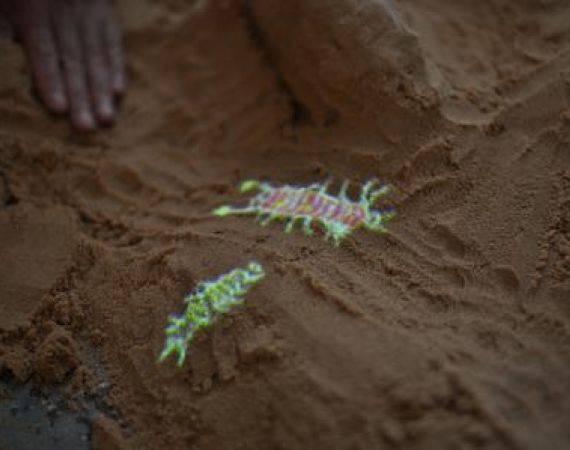Posted on Wed 9 Nov 2011
Last Week's Lunchtime Talk: Introducing Squidsoup
The Studio's weekly Lunchtime Talks are open to anyone to attend and feature members of the Studio community and invited guests presenting their projects and inviting discussion. Attendance at the talks has been growing steadily over the last few months, so we thought it was time to start…

Squidsoup lunchtime talk
Posted by
The Studio's weekly Lunchtime Talks are open to anyone to attend and feature members of the Studio community and invited guests presenting their projects and inviting discussion. Attendance at the talks has been growing steadily over the last few months, so we thought it was time to start documenting them for people who can't attend.
On Friday 4 Nov new studio residents Anthony Rowe and Gaz Bushell from Squidsoup joined us to introduce their practice and to present some of their projects that explore digital and interactive experiences.
In 1997 Squidsoup, an international group of artists, researchers and designers (UK/NO/NZ) gave themselves the challenge of delivering on the promise and hype surrounding ‘new media’. For several years they did client work in parallel with, and as a funding mechanism for more creative projects. Following the dot.bomb they took the opportunity to work more on artists commissions with organisations like the Arts Council and The Clark Bursary, and now work exclusively on combining sound, physical space and virtual worlds to produce immersive and emotive headspaces where participants can take active control of their experience.
Squidsoup have a longstanding relationship with Watershed and told us about some of their early project working on projects such as Virtual Puppeteers which gave young people the tools to create characters and sets and generate a virtual puppet theatre in their computers. Ghosts, which is a digital sculpture made up of fragments of throwaway thoughts and ideas in text from online instant messages, mobile phone texts and emails. It has since been developed and now uses an iPad to enable live inputting of text content and has been exhibited in the RSC. Come Closer is a 3D real time visualization of movement and proximity that encourages participants to explore and challenge perceptions of personal space and using wearable technology and the body to create collaborative and responsive interactions. Anthony Rowe directed us to Edward T Hall’s book on proxemics, or personal space, The Hidden Dimension that informed their work and deduced that 1.2 meters appears to be a comfortable distance for most people. Through Come Closer Squidsoup have tested this hypothesis and you can read more about their findings here.
Through their project Driftnet participants could experience the sensation of flying like a bird through virtual space. Long before the Kinect opened doors to dynamic depth mapping, Squidsoup experimented with comparing a pair of camera images in real time, using a Point Grey Bumblebee stereo-vision camera to allow the participant to twist, turn and move around the space to simulate flight with their arms outstretched as a pair of wings.
Anthony told us that Squidsoup have always been more interested in immersive experiences than in computers and screens. They approach their work from an interaction design perspective and value real things in real places with a physical presence. This can be difficult in a digital, social realm and can create challenges when involving more than one participant at a time.
Building on the successes of Driftnet, and with a view to how we can use interactive experiences to play together, Squidsoup developed one of their most recent projects, Glowing Pathfinder Bugs. Using the ubiquitous nature of our ability to embrace 3D mapping when building sandcastles, the project encourages playful interaction with projected bugs that react in real time to the topography of their sandpit environment. Ant and Gaz told us about the amazing variety of reactions that people have had to the work. While some adults will carefully cultivate and encourage the safe passage of the bugs, creating channels and carrying them to safety, small children have taken great delight in smashing and burying the bugs in the sand and Glastonbury audiences furiously bashed away at the bugs until one giant super-bug emerged victorious. To find out more about the project and see some of the videos take a look at www.squidsoup.org/bugs.
Ant and Gaz told us that they were becoming increasingly inspired by the idea of a designed, 3D environment made of light that would be fully programmable and reactive to sound or movement. Using the Nova developed by ETHZ/Horao GmbH they started to play with a modular cube of 1000 programmable points of light, encouraging playful uses such as Stealth a game without obvious rules played out in the V&A that is a bit like a game of Connect 4 in 3D.
This was great research but Squidsoup wanted to have a larger, more flexible, programmable and relatable canvas to work on with light that could be sharper and more distinct. They developed a 12x12x24 grid of LEDs on flexible cable that created a floor to ceiling frame of lights, resembling more a field of bamboo or a bed of seaweed than a solid cube. Treating one light as one pixel in a 3D image, Squidsoup were able to test different solid and fluid shapes, create virtual landscapes, movements and reactions to audio stimulae. This project became Scapes which was commissioned by Tenderpixel Gallery and later installed in ARS Electronica for 3 months. Ant spoke about how Scapes allowed Squidsoup to ‘paint in 3D with sound and light’, a process the French dubbed ‘passage du lumière’.
The attendees of the talk asked Ant and Gaz whether anyone else could create content for Scapes and unfortunately this is not yet possible but it is definitely on the cards and something they’d be interested in working on in the future.
They were asked if it was still their aim to create an enterable space. The exposed chips and LEDs currently snag on clothing and the electronics can short if handled too roughly so it is not currently possible to walk through the lit environment. They would definitely like to alter this in the future and experiment with more playful interactions between the structure and the participants. They would also like to use what they’ve learnt in Glowing Pathfinder Bugs to track people as they move through the grid and respond dynamically to their actions, although the complexity of the 3456 points of addressable light does present certain challenges in identifying individual movements.
Thanks very much to Ant and Gaz and all at Squidsoup for their open and inspiring talk and we look forward to working closely with them as they join us in residence at the studio.
